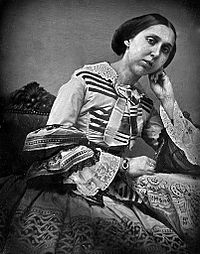Princess Eugenie of Sweden
| Princess Eugenie | |||||
|---|---|---|---|---|---|

Princess Eugenie (Daguerreotype photo)
|
|||||
| Born |
24 April 1830 , , Sweden |
||||
| Died | 23 April 1889 (aged 58) , , Sweden |
||||
|
|||||
| House | Bernadotte | ||||
| Father | Oscar I of Sweden | ||||
| Mother | Josephine of Leuchtenberg | ||||
| Full name | |
|---|---|
| Charlotte Eugenie Augusta Amalia Albertina |
Princess Charlotta Eugenia "Eugénie" Augusta Amalia Albertina of Sweden and Norway (, 24 April 1830 – 23 April 1889 in ) was a member of the Royal House of Bernadotte and a dilettante artist and philanthropist.
Eugénie was born to King Oscar I of Sweden and Josephine of Leuchtenberg as their 4th and second last child and only daughter. She was named after her maternal grandfather, Eugen of Leuchtenberg.
She later wrote of her childhood: "During the years of my childhood I never had a girl of my age for a friend or playmate. Nor did I ever have a doll, but exclusively played boy's games with my brothers." She particularly enjoyed the summers at Tullgarn Palace. Her closest friend was Prince Gustaf, Duke of Uppland, her favorite among her siblings. She was later to say, that during her childhood, she had the wish to be a boy just like her brothers were. Princess Eugénie was placed under the supervision of her senior lady in waiting Karen Anker, and educated with her siblings by the royal court chaplain dr J. G. Lundberg. Anker and Lundberg were both dominant personalities, which is regarded to have formed the consciously submissive character of Eugénie. In 1843, she accompanied her parents on their trip to her maternal grandmother in Bavaria. Eugénie was later to be known for her fragile constitution. This has been attributed to the fact that one of the teachers of the siblings were once ill with tuberculosis, but was allowed to remain in employment, which may have affected the health of some of the children. In 1844, she took ill with a grave cold.
Princess Eugénie had her confirmation in the royal chapel in the Stockholm royal palace 25 October 1845, and was thus considered an adult. The following years, she participated in high society and balls, and was regarded as quite pretty. Contemporaries describe her as having regular features, beautiful hands and big, glowing dark eyes: "her entire being glows of life and goodness", and that she was "much to her advantage in red and gold" in a Spanish costume at a masquerade ball. Eugénie accompanied her brother Charles to Prussia in 1846 with the thought that she might be presented there as a prospective bride, and she was given proposals from emperor Napoleon III of France as well as from princes in both Denmark and Germany, but none come to fruition. The reason was likely that she had no wish to marry. She stated herself that she appreciated the "sweet, independent life" her unmarried status gave her: according to the Civil Code of 1734, all unmarried women was under the guardianship of their closets male relative unless she petitioned for legal majority, and when a law reform in 1858 allowed for unmarried women to be automatically declared of legal majority by a simple application to the closest court, Eugénie belonged to the first women to use this right. Early on, she had a great interest in the arts, and was active as a composer, painter, sculptor and writer.
...
Wikipedia
